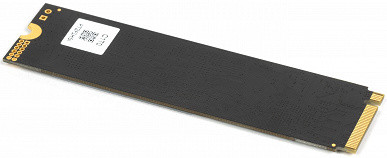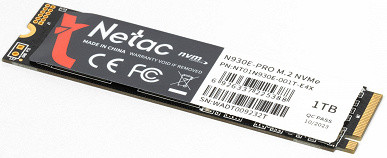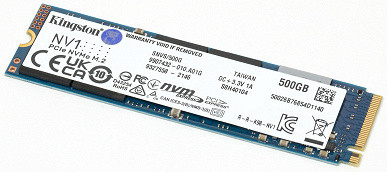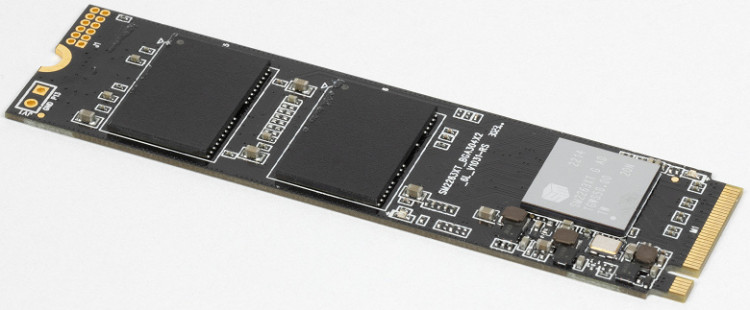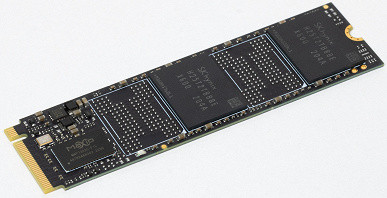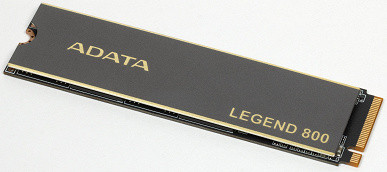The transition from SATA/AHCI solid-state drives to PCIe/NVMe turned out to be difficult and protracted. The main reason is not only the change in the interface, which appeared in the mid-2000s, but also the new software protocol, which requires support from both the UEFI of the motherboard and the operating system. However, if you consider the SSD as a simple data storage device, you can connect it even to an old motherboard based on Intel i915P via an adapter. At the same time, even if the system does not support PCIe Gen3x4, working with a slower interface is possible, although impractical.
Old computers have problems booting from a new NVMe drive due to the incompatibility of their BIOS. If you find a rare PCIe drive with AHCI support, you can avoid this difficulty. But such devices are almost never found, since their production ceased about 10 years ago. Starting with the LGA1155 platform, more motherboards have appeared with the ability to modify the firmware to support booting from NVMe. About 10 years ago, the UEFI issues disappeared, and new motherboards provide built-in NVMe support.
While this may seem like an old topic, many older computers are still in active use. Desktops offer easy solutions for installing new drives, while laptops often only have one 2.5-inch bay, limiting the choice to SATA drives. Despite this, older NVMe models should not be completely written off. SSDs that support PCIe Gen3 can be replaced with newer Gen4 or Gen5, which is often useful.
However, most major manufacturers have already abandoned the use of older controllers. There are still older models on the market that are sold at reduced prices. The availability of relatively old memory also allows these controllers to be supported, although modern solutions are not suitable for them. Thus, it is still possible to find long-lived drives from second-tier manufacturers that remain relevant for certain tasks.
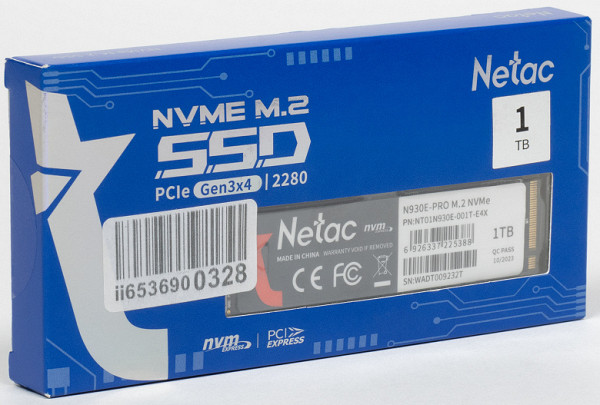
For example, the Netac N930E Pro SSD, which became our main focus, has been on the market for about four years. However, this does not mean that it has remained unchanged — the memory has changed more than once in its production. Certainty, however, is not Netac's strong point: it is difficult to find a model that would be used on the same controller, because this SSD is found both with Silicon Motion SM2263XT and Realtek RTS5766DL. In general, this is a typical budget SSD that can be bought not only on AliExpress, but also in regular stores with a local warranty. Despite the fact that its price attractiveness may leave much to be desired compared to newer competitors, it is still in demand.
Why buy such a «pig in a poke» that initially does not pretend to be something outstanding? Firstly, it is inexpensive, and QLC memory has not been found in it before, which inspires a certain confidence. Many buyers do not think about compatibility and look for something similar to old models for the old system. They find a lot of reviews that may be outdated, but they are convinced that this SSD suits them, and calm down. On the Internet, you can find many horror stories about overheating of modern SSDs, which are often exaggerated, and discussions about the implementation of QLC in new devices. Often this happens without changing the name of the «old» SSD, but many do not go into details. In addition, there are fears about problems with large brands, such as some batches of Samsung 870 Evo, which makes many wary not only of this model, but of all Samsung SSDs. Netac is also written a lot, and often justifiably. However, a familiar product always inspires more confidence, even if it seems familiar only at first glance. Today we decided to find out whether this is still an old friend or its successor. As already said, it is important to regularly check budget products in order not to lose hope for progress. Experience shows that such checks should not only be conducted frequently, but also that the results should be demonstrated to all interested parties. Once is not enough, so today we will have another review.
Netac N930E Pro 1TB
Last October isn't that long ago. At the end of that year, we tested an all-in-one with an SSD from the same line. Although it was considerably smaller, the fact that such a drive can be purchased without explicitly stating it is significant. Some may be wary of this, but considering the many OEM drives, the Netac is probably the best choice. From the outside, there's nothing special: the design is one-sided, and all the interesting details are hidden under a sticker that should not be removed, lest you lose the warranty.
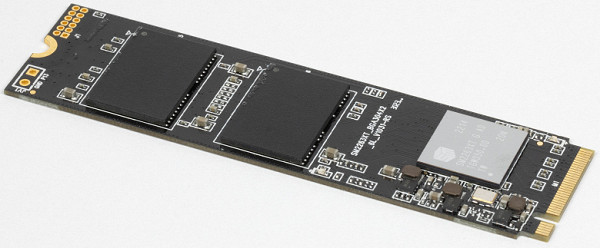
However, there is nothing outstanding under the sticker either. The most common controller in this line is the Silicon Motion SM2263XT, which has been around since at least 2020. The memory chips are not marked, so it is not known who was involved in their packaging and testing. A regular 176-layer Micron B47R TLC flash is used, which became popular due to its low price with good characteristics and quickly entered both budget and top SSDs. Although it has lost some of its appeal now, its potential speeds will not help the SM2263XT controller, since all the performance issues of this line of controllers are internal. However, the configuration is better than it could be for this money. For example, the NV2000 SSD in our stores often costs a little less than the N930E Pro and, as a rule, has a version with Maxio MAP1202, which is superior to the SM2263XT in many respects. However, there is no guarantee that you won't come across a less successful HG2283.
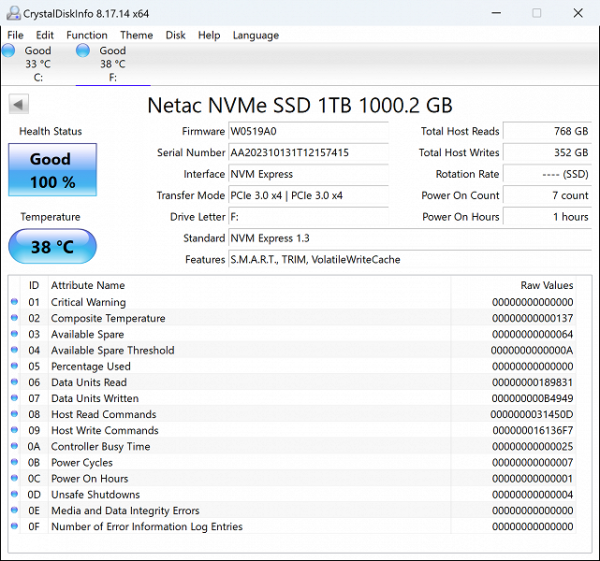
So, there is a high degree of uncertainty in this segment. Configurations are difficult, as is high-end memory. B47R chips come in different grades, and when it comes to Micron, it is difficult to make any predictions, especially if the chips come from unverified sources. Specifications are often written at random: for example, Netac specifies a read speed of up to 3500 MB/s, but does not specify that this value is “up to” and no controller in this line is capable of this, regardless of the memory used. This means that it is important to remember the real characteristics, but you can get rid of such shortcomings only for additional money, which is not always possible or desirable. So it is worth considering these points, but manufacturers can “do wonders” not only in the budget segment, and this should be taken as a given. In any case, it is useful to see how this SSD works in practice.
Testing
Testing methodology
We are using a test bench with an Intel Core i9-11900K processor and an Asus ROG Maximus XIII Hero motherboard on the Intel Z590 chipset, which allows you to connect an SSD in two ways: via the “processor” PCIe Gen4 lines and the “chipset” PCIe Gen3 lines. The first option provides the maximum performance of modern SSDs, while the “compatibility mode” also has its value. The chipset PCIe controller appeared in Intel’s “hundredth” series chips, that is, in 2015, and has not changed much since then. This is exactly what a user of an old computer will see when installing a modern SSD in it. Today, we will focus on testing using the chipset controller, given that the devices in question are not the most modern.
Samples for comparison
Using this opportunity, we can also discuss some research topics. For example, we have already tested a couple of SSDs on the same controller. The Kingston NV1 used the same memory, but half the capacity. The Digma Mega S3 also had a terabyte capacity, but it was formed from 128-layer YMTC memory. So it will be useful to consider how this affects performance when using the same controller. Although the controller is getting old, it is still interesting for the overall understanding of the situation.
At the moment, you can choose your competitors quite freely. We decided to stop at the Ardor Gaming AL1288 and Adata Legend 800 models. Both have a capacity of one terabyte, but the first one uses a Maxio MAP1202 controller and 128-layer TLC memory from SK Hynix, and the second one uses a Silicon Motion SM2267, operating in SM2267XT mode, without DRAM and with 144-layer QLC flash from Intel. The prices for these models in local stores are almost the same as the price of the Netac N930E Pro, which gives an additional reason to compare them — whether to trust a familiar option or try something new.
Filling in data
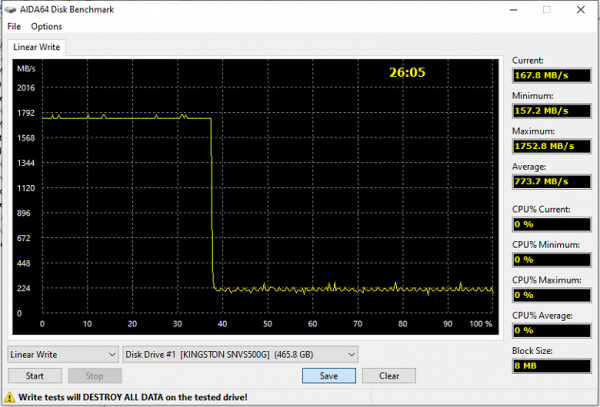
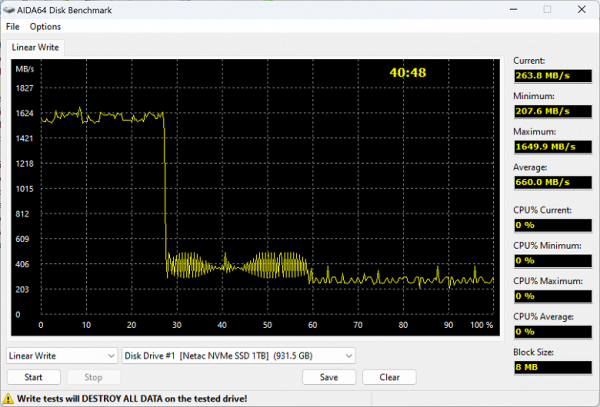
Let's start with scalability by volume. As you can see, small improvements are obvious — we managed to earn about fifty megabytes per second. When writing to the cache, the speed is even slightly lower, which is explained by the limited capabilities of the controller. The SLC cache volume is slightly smaller, since the SM2263XT, unlike its SATA colleagues, allows this. This may cause concern among buyers, since a sharp drop in speed after reaching a quarter of the volume resembles the behavior of QLC. However, this is not so — just the peculiarities of the controller and its algorithms.
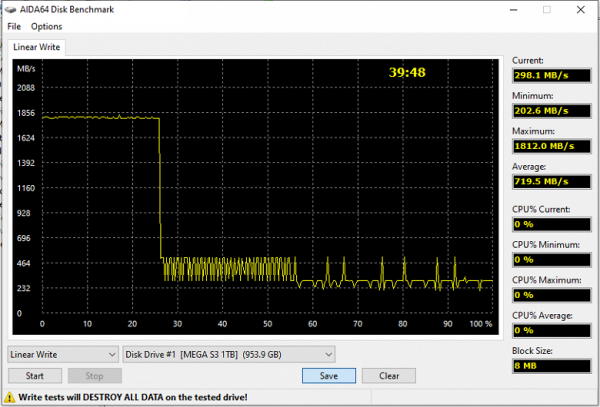
The specific type of memory in this case does not matter much — Digma Mega S3 shows almost identical performance. However, among all three models, Netac has the greatest «hairiness» and the lowest write speed to cache, which can be interpreted as an indicator of memory quality. Although this is not necessary — it may just be a coincidence.
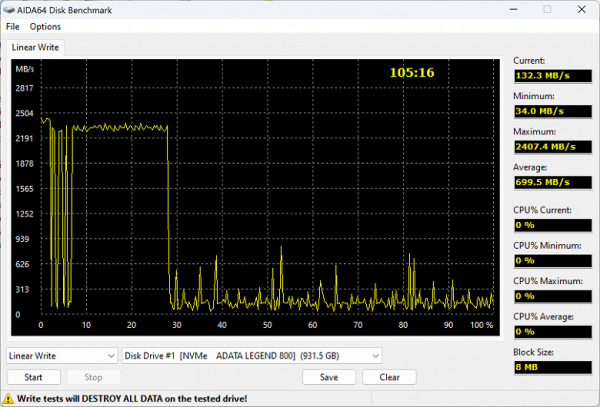
But what can you expect from this price segment? For example, there is a slightly more modern controller with QLC memory. It demonstrates a slightly higher write speed to the cache, although it still does not do without failures. In addition, the speed outside the cache can drop not to one and a half to two hundred megabytes per second, but to three dozen. However, the total test execution time differs by two and a half times. Let us remind you that the Legend 800 is even a little more expensive in retail. Although there is a nuance: it is one of the most affordable SSDs with PCIe Gen4 support, but is this support worth it if the controller cannot use it properly? Perhaps this only makes sense for PlayStation 5 owners, where Gen3 is not suitable, and the built-in drive is not very good, so any external drive will be better — but this is a rather narrow case.
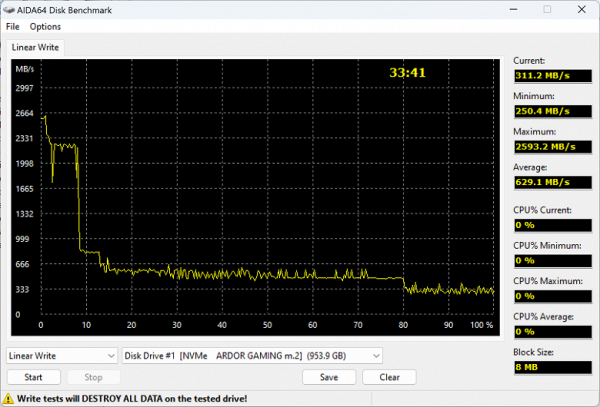
On the other hand, for almost the same money, you can find more interesting options. As we have already noted, MAP1202 paired with SK Hynix memory shows worse results than with YMTC, but even such indicators are quite good. The main point is that the cache is small here, but the speeds beyond it are quite acceptable. Even if you have to free up space — which in practice happens quite rarely. This means more stable operation without sharp fluctuations, which is so lacking in the modern world, especially in the budget segment.
Maximum speed characteristics
Low-level benchmarks, including CrystalDiskMark 8.0.1, have long been victims of the unequal fight with SLC caching and, in fact, can only test the cache itself. However, the information about the performance of devices provided by manufacturers is also limited by the limits of this cache, so it is useful to check this data. It is important to note that work on caching is carried out precisely in order to “hit the cache” as often as possible in real conditions and demonstrate high speeds, despite the reduction in the cost of memory.
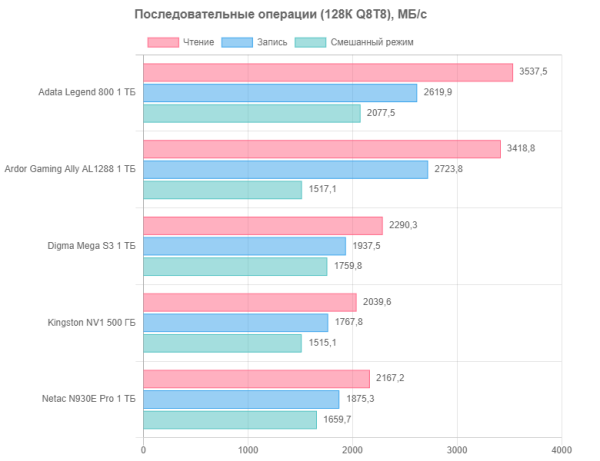
The controller in the Adata Legend 800 is the “newest”, although PCIe Gen4 support is only formal. Memory does not affect the results, since the benchmark works exclusively within the SLC cache. Compared to the cheaper Ardor Gaming, this does not provide a significant advantage, but in the Silicon Motion line, the SM2267XT shows a clear advantage over its predecessor, the SM2263XT. Of the three participants in the test, the fastest was the SSD with a terabyte of YMTC memory, although the differences in performance between them are insignificant.
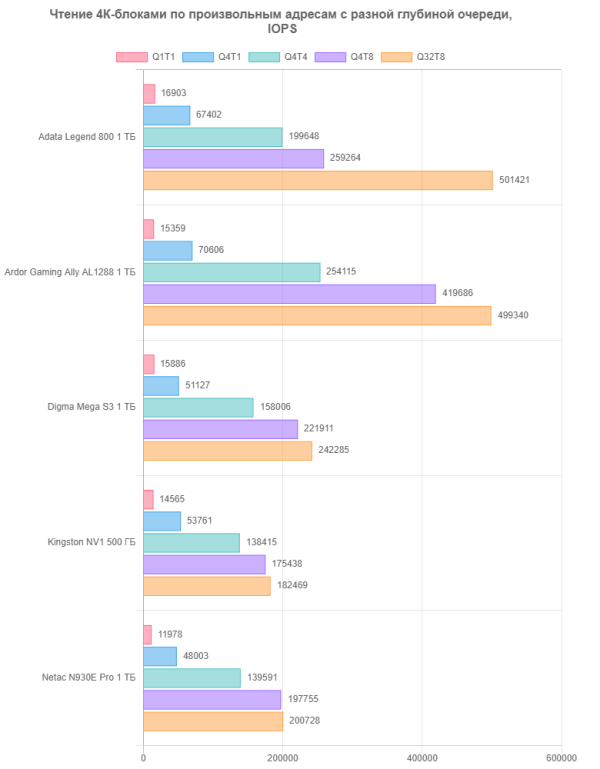
The Netac N930E Pro looks rather dull in the context of a discipline that is still popular among a wide audience. Of course, 12 kIOPS significantly exceeds the needs of most regular personal systems. However, in terms of sports achievements, this figure could be higher.
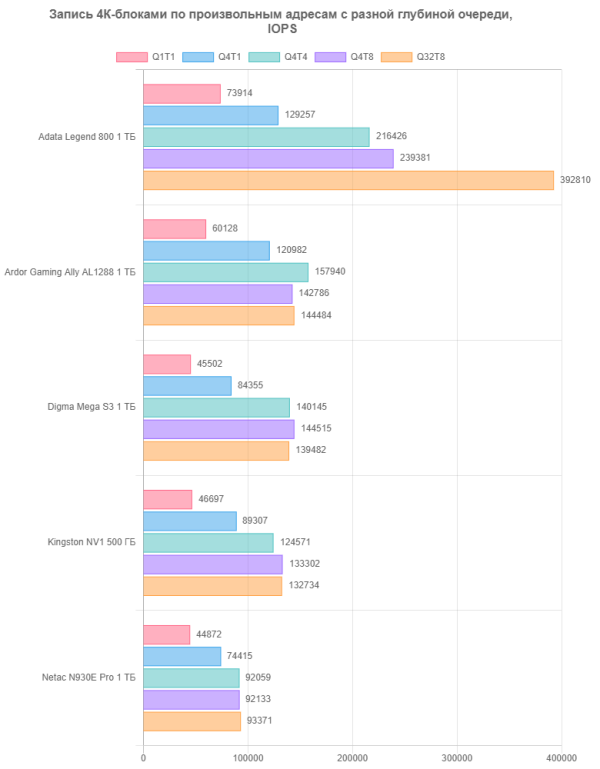
When recording, the Netac N930E Pro shows a greater lag than expected from its closest analogues. With its “non-relatives,” everything is clear — they have more powerful controllers. However, the same SM2263XT is used here, and the memory configuration is very similar. But it is worth noting that delving into these details was interesting four years ago; now it is wiser to take a step up to another level, which may not be more expensive.
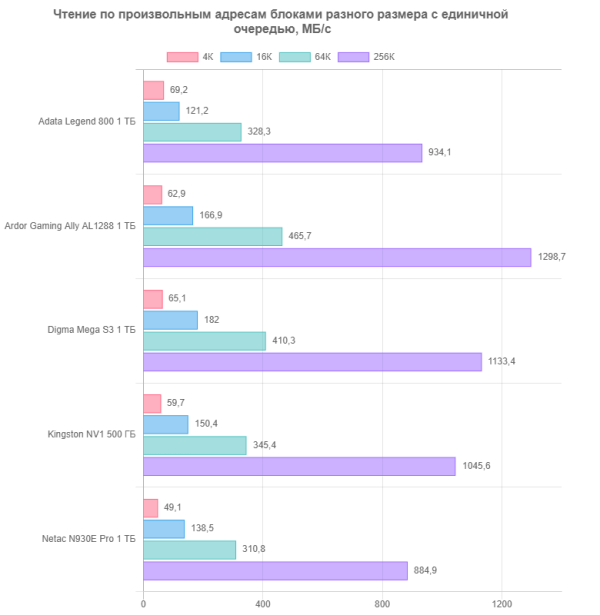
This is the case when a terabyte of QLC is no longer enough, even in low-level benchmarks. Moreover, the scenario is much more realistic than simple 4K reading and writing with queues. However, for the main test subject, this does not help much on the one hand. On the other hand, it is not so important, since the requirements of application software are much more modest than the capabilities of even budget SSDs.
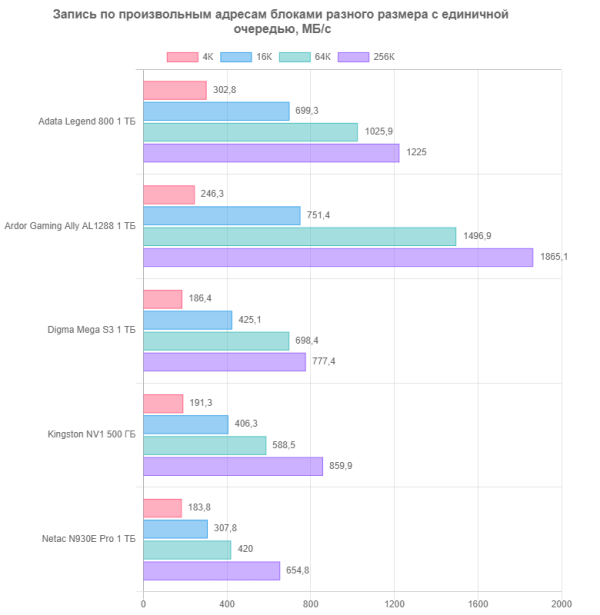
Perhaps this is the approach that firmware developers for devices in this segment have long adopted. If the performance is still excessive for practical use, why strive for improvements that no one will notice? In terms of abstract tests, the device will look worse than it could, but buyers rarely pay attention to numbers. In addition, SSDs on this platform have long ceased to be the heroes of most reviews. Therefore, it makes sense to direct programmers' resources to other tasks. The main thing is that the device simply works.
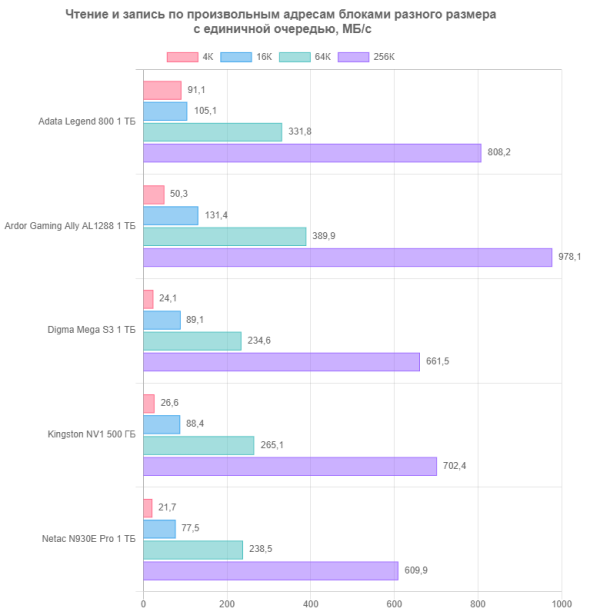
Mixed mode is also important, because in real life (unlike in test utilities) it is rare to encounter a situation where data is only written or only read for a long time. This is especially true in multitasking environments and given the complex internal life of modern operating systems. However, we will not see anything new here. It made sense to squeeze performance out of Silicon Motion SM2263XT in the context of completely different configurations. Micron's 176-layer memory is used not because it is very fast — the controller cannot fully utilize its potential. It has simply become affordable for a long time, which encourages its use even with outdated budget controllers. How this is reflected in the figures is a secondary issue. A modern buyer will definitely not understand this.
Working with large files
Although the results in low-level utilities can be impressive, it is not always possible to achieve such speeds in practice. This is due to the fact that tests such as CrystalDiskMark work with relatively small portions of data, and all of them are located inside a single file. Firstly, such a file in modern conditions is almost always stored in the SLC cache throughout the entire test. Secondly, service operations of the file system are not taken into account — writing one file also includes modifying the MFT and working with journals (most file systems used are journaled, including NTFS). Therefore, writing does not occur sequentially, but to different places and in small blocks. For a more accurate practical assessment, the Intel NAS Performance Toolkit is better suited, which allows you to test not only the cache, but also the device in more realistic conditions, when there is almost no free space. This is exactly what we do.
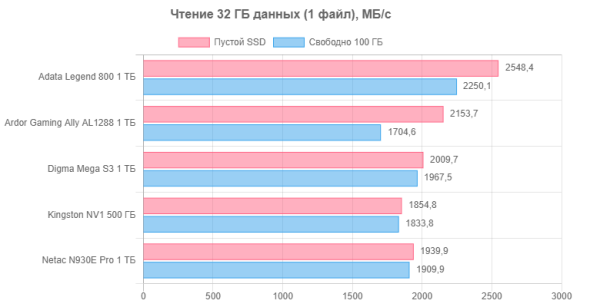
Single-threaded operation is the most common scenario (146% of cases), but also the most difficult. However, it is rarely paid attention to, especially by buyers of budget SSDs on older platforms. The main reason for buying them is that they are perceived as familiar and proven solutions that cause less concern than new products. And, besides, it is still not SATA, although many are still quite happy with the latter.
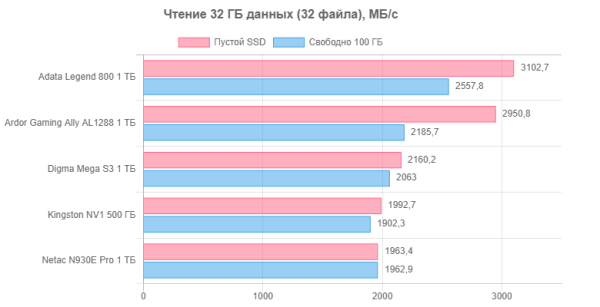
Usually, only the multi-threaded read mode allows drives to reveal their potential, but it is in this aspect that many modern participants are limited. Let us remind you that Netac declares a speed of up to 3.5 GB/s for its line, which none of the controllers used are capable of in principle. This problem concerns not only Netac, but also many other four-channel budget controllers, which, although not too old, can reach this level in CDM, but not in real work with files. At the same time, it is worth noting that this is still three to four times faster than SATA, even in theory. You can calm down on this, if you forget that faster solutions can be found for just a small surcharge. Several years ago, it was not possible to get by with little bloodshed, which made such platforms in demand. Now, in fact, the train has already left, but not everyone has noticed it.
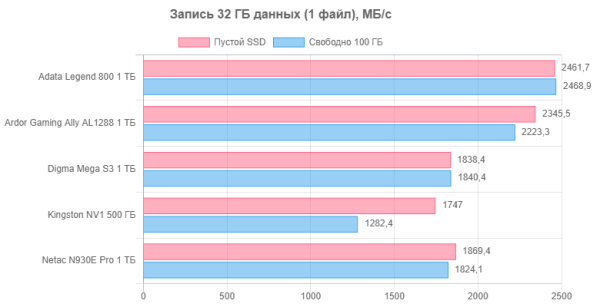
Low memory write speed is usually masked by SLC caching. We have developed a method that allows us to break through this «masking», but this is not always possible — programmers do not get their salaries for nothing. Outdated budget platforms with fast memory end up losing. For example, Micron B47R on the SM2263XT controller cannot fully use its speed capabilities, which leads to it being inferior to SM2267XT with QLC, which more or less fits into the cache. It is good that old problems related to incomplete clearing of SLC cache in firmware have finally been fixed. The practical implementation of these shortcomings is clearly demonstrated by Kingston NV1 — it would seem that there should have been enough space, but it did not work out. Mega S3 and N930E Pro cope, but their absolute results are no longer very high by modern standards.
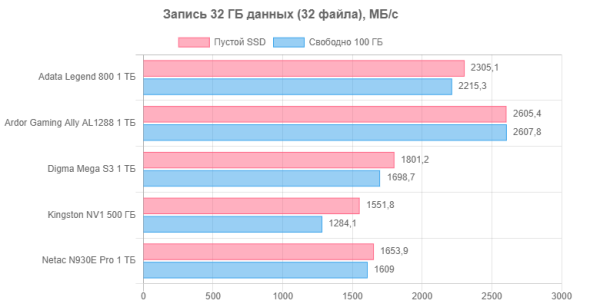
It doesn't matter whether we are talking about single-threaded or multi-threaded mode: the operating algorithms inside the drive remain the same, so the problems remain the same. Considering that we are talking about rather weak controllers, the absolute results here are also somewhat lower than in single-threaded mode.
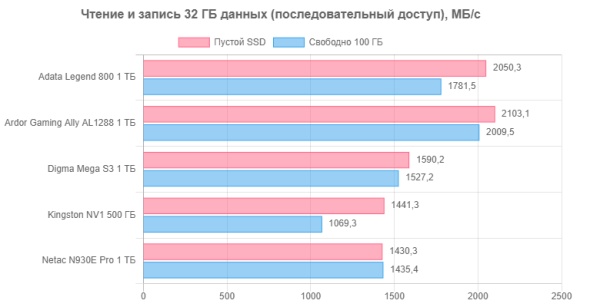
Which had an effect in this case. Modern top controllers in these scenarios make us remember that PCIe is a duplex interface. For older budget ones, these are much more serious loads than simply transmitting data in any direction in one stream. With all the consequences.
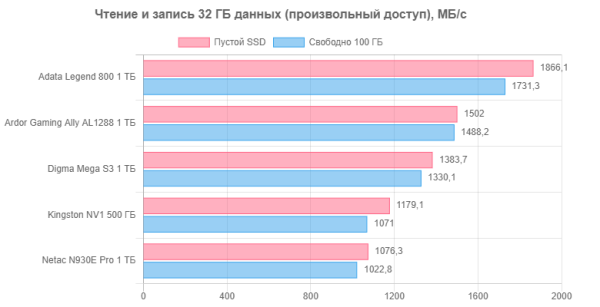
Random addressing is implemented even worse, but the achieved speeds are still significantly higher than even the potential capabilities of SATA. At one time, this was the main driver of the attractiveness of «budget NVMe» — an inexpensive compromise on speed. However, the main factor influencing the price is the cost of memory, which is why it will not be possible to save much on the controller. If you do not strive to squeeze out the last cent, you can choose a more modern controller — even if it is also a bufferless four-channel, the performance will be higher. The main problem with such platforms is that the new fast memory turns out to be useless to them, since they cannot effectively use it.
Comprehensive performance
At the moment, the best comprehensive benchmark for storage devices is PCMark 10 Storage, a brief description of which can be found in our review. We noted that not all three tests in the suite are equally useful — the best results are demonstrated by the «complete» Full System Drive, which covers almost all common scenarios: from booting the operating system to simply copying data (both internal and external). The other two tests are just subsets of it and, in our opinion, are not so interesting. However, this test is useful in that it allows you to accurately measure not only the real throughput when performing practical tasks, but also the delays that occur during this. Averaging these metrics across different scenarios and bringing them to a single number may seem a little synthetic, but at the moment this is the only way to get a more realistic assessment «in general», and not just in individual cases. Therefore, it makes sense to familiarize yourself with it.
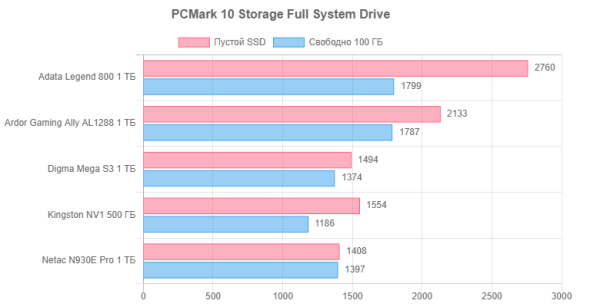
The memory, as has been noted many times, has high speed from various points of view. However, the controller does not match it, as it was developed with the slower flash in mind. As a result, despite stable results, they remain low — and this is not good. The drive can be used, and the risks associated with the fact that the cache will not cope with the tasks and the performance will drop to a minimum are much less than with more modern SSDs with QLC. These are its advantages. The downside is the speed, which even in ideal conditions barely exceeds this minimum. Three or four years ago, such results looked quite acceptable — they were faster than most SATA drives and significantly cheaper than top NVMe devices. However, when compared with more modern budget models, the situation already looks less optimistic.
Total
This model remains a kind of long-liver in its segment, and over the past years it has not only not worsened, but even become better, although much depends on luck. Netac never promised a stable hardware configuration for the N930E Pro, freely changing the controllers in these models, which makes the lack of a guarantee for fast memory a serious drawback. In addition, the potential speed of the memory turns out to be unclaimed. For example, the Micron B47R paired with more modern InnoGrit IG5220 or Silicon Motion SM2269XT no longer copes with PCIe Gen3, since such drives can reach 4-5 GB / s in sequential access scenarios. Although they are slightly more expensive, the difference in price is insignificant. At the same time, part of the difference may depend not only on the controller, but also on the quality of the memory, which can vary in durability. If the modules are manufactured by Micron, this is one thing, and if by a subsidiary of SpecTek, it is another. When testing and packaging are performed by unknown companies, it is difficult to predict durability. Why is the outdated model still in demand on the market? The main reasons are that the familiar is better than the unfamiliar. There are many reviews and overviews, which creates the illusion of reliability. Many buyers of budget devices forget that support for new interfaces is not the main advantage of modern controllers. Therefore, they look for inexpensive SSDs for PCIe Gen3 to upgrade their computers and find exactly such models. This process can last a long time until Netac stops supplying the N930E Pro. As long as these SSDs continue to be bought, there is no point in removing them from sale — the manufacturer has never chased high margins, preferring to act on the principle of «little bloodshed». Only buyers can break this circle, or, more likely, if the controllers of this class are exhausted on the market.

